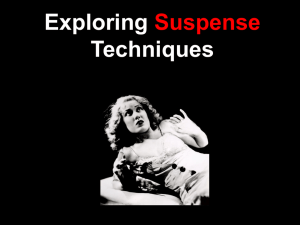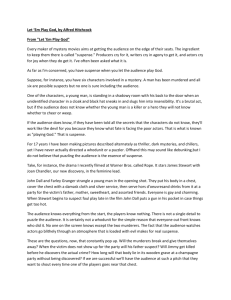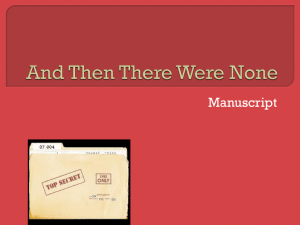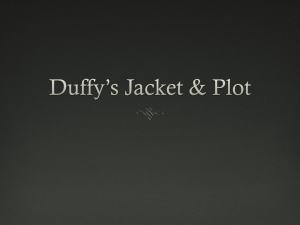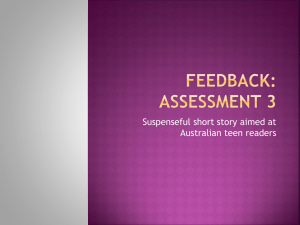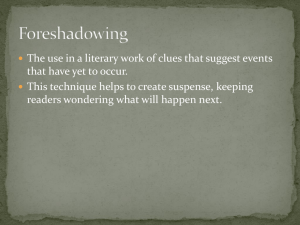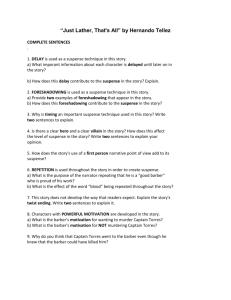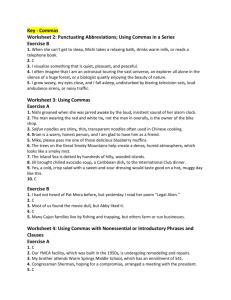Hitchcock, North by Northwest, and Suspense
advertisement
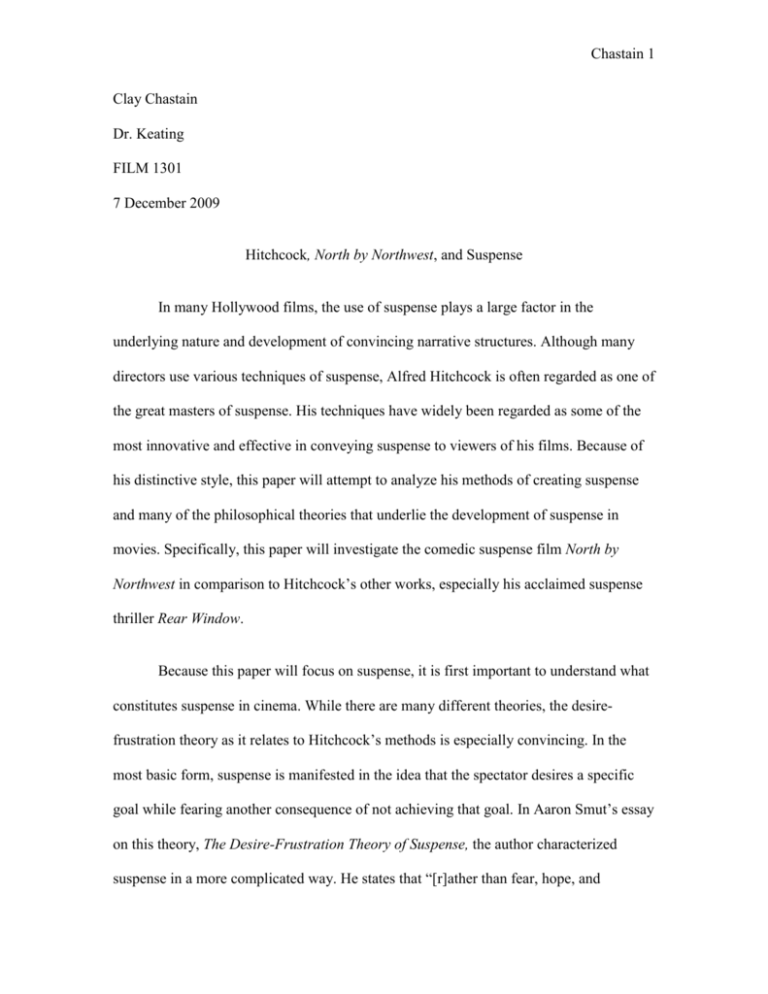
Chastain 1 Clay Chastain Dr. Keating FILM 1301 7 December 2009 Hitchcock, North by Northwest, and Suspense In many Hollywood films, the use of suspense plays a large factor in the underlying nature and development of convincing narrative structures. Although many directors use various techniques of suspense, Alfred Hitchcock is often regarded as one of the great masters of suspense. His techniques have widely been regarded as some of the most innovative and effective in conveying suspense to viewers of his films. Because of his distinctive style, this paper will attempt to analyze his methods of creating suspense and many of the philosophical theories that underlie the development of suspense in movies. Specifically, this paper will investigate the comedic suspense film North by Northwest in comparison to Hitchcock’s other works, especially his acclaimed suspense thriller Rear Window. Because this paper will focus on suspense, it is first important to understand what constitutes suspense in cinema. While there are many different theories, the desirefrustration theory as it relates to Hitchcock’s methods is especially convincing. In the most basic form, suspense is manifested in the idea that the spectator desires a specific goal while fearing another consequence of not achieving that goal. In Aaron Smut’s essay on this theory, The Desire-Frustration Theory of Suspense, the author characterized suspense in a more complicated way. He states that “[r]ather than fear, hope, and Chastain 2 uncertainty, the desire-frustration theory holds that suspense results from the frustration of a strong desire to affect the outcome of an imminent event" (287). Essentially, rather than the simple breakdown of fears and hopes, the desire-frustration theory helps to explain they why of the thrill of suspense. Smuts describes this theory in the sense that “the frustration of a strong desire to affect the outcome of an imminent event is necessary and sufficient for suspense" (281). However, Hitchcock himself develops his own description of effective methods of displaying this type of suspense. Smuts notes that “[a]ccording to Hitchcock, the key to the most effective method of arousing suspense is to give the audience some crucial information that the characters lack . . . [and that while] not the only technique for creating suspense, but it is an extremely effective one" (281). At the same time, it does appear that both techniques are not mutually exclusive – they reach the same ends regardless of their formation. Moreover, it is important to understand how suspense is broken down in order to properly analyze why both ideas of suspense reach the same goals. Smuts states that there are three factors in the formation of suspense, noting that “[i]t is widely thought that suspense requires uncertainty, but we often feel suspense in response to narratives when we know their outcomes [and that] although we frequently feel suspense intensely in response to narrative artworks, we seldom feel it in our daily lives, [and finally that] [t]ypically, the amount of suspense we feel diminishes on repeated encounters with a narrative…” (281). In many ways, the structure of suspense reflects its results. This analysis of suspense here provides an indepth view of how suspense operates on the viewer. In a more general relation to the audience, the viewer knows that "... what we find in all suspenseful narratives and in all suspenseful situations in real life are factors that suspend our efficacy by frustrating our Chastain 3 ability to work toward the satisfaction of a desire. Suspense only arises when our ability to make a difference is radically diminished. Suspenseful situations are those where we want to affect an outcome -- that is, where we strongly desire to have a causal impact -but our desire is frustrated" (284). Essentially, the desire-frustration theory relates to why we feel, as viewers, a sense of helplessness to be able to interact with the characters on screen and why this builds a sense of suspense when watching a film. Smuts describes this as an opposite to our reality as viewers, stating that “unlike real life, where we can actively work toward the satisfaction of a desire, we are completely powerless over narratives" (285). In this sense, the viewer is trapped in a situation where he or she cannot actively communicate with the actors on screen, limiting the ability of a viewer to respond. This, in turn, creates the effect of suspense that we encounter on screen. Smuts sums up these ideas, stating that ”[the viewer feels] suspense not simply because we know something that could potentially save the life of a character, but because no matter how strongly we desire to help, we cannot do anything with our knowledge" (289). This underlying theory can be explored in many Hitchcock movies, especially in the comedic suspense that North by Northwest conveys to its audience. From the beginning of the movie, the viewer wants to intervene into the conflict and either say to the antagonist kidnappers that Thornhill is actually the wrong man or to inform Thornhill of his impending danger. Even further into the movie, the viewer wants to help Thornhill avert the crises he is encountering, such as being set up to drive drunk off of a steep mountain pass or to question the motives of the romantic blonde woman he meets on the train. Throughout the film’s plot, the viewer is engaged into the story because he or she wishes there was a way to interact with the scenes on screen in order to give a favorable Chastain 4 outcome. But, because the viewer is unable to help with the events unfolding in the plot, they are enticed into the same notion of suspense that is described by Smuts. Similarly, other Hitchcock films, the idea of Smuts suspense can be put into play. In Rear Window, the viewer is confronted with similar choices; he or she wishes that it was possible to interact to with the detective to solve the murder before the protagonist is put into mortal jeopardy. However, it is important to understand the various aspects of suspense and how they relate with Hitchcock’s methods. As mentioned indirectly by Smuts, the concept of viewers being able to interact with the actions on screen is a large part of suspense. And, in conjunction with this idea, Jan Baetens discusses the structures of screens and how they interact with narratives. In his article, he explores the methods constructed by Hitchcock, stating that “the idea of capturing the seduced and paralyzed audience was [important for Hitchcock]” (3). Baetens argues that many of these suspenseful moments occurred through the implementation of varying screen techniques. He describes the idea of screens in that ". . . [they] can perform all types of actions and functions, which means that screen theory will have to deal automatically with contradiction” (3). Essentially, the contradiction appears in the sense that “[a] screen is not only an object where signs appear, but also an object that prevents us from seeing . . . [so that] screens hide as much as they reveal; they can only reveal to the extent that they also hide something, and vice versa" (3). Because of this, screens represent a force that obscures and constricts a viewer from seeing a complete picture. It limits the viewer, forcing a constrained notion of the actions within the film, heightening, therefore, the inability of the viewer to interact with the narratives unfolding on the screen, as Smuts would claim. From this philosophical Chastain 5 viewpoint, this is a large factor in how Hitchcock develops suspense. Baetens claims that there are a “. . . tremendous number of relationships among all these different levels and aspects [so that] the material sense of looking [is] being linked with many cognitive strategies of interpreting and understanding the very act of looking. For instance, one can ask what Hitchcock actually wants us to see, and why" (3). As a result, Hitchcock uses the idea of screens to influence how the audience knows what they know, limiting again the ability of the viewer to interact with the actions portrayed in his films. One obvious aspect of film and its ability constrain and limit perspectives is in the actual angles and camera techniques used in a movie. Hitchcock, being the suspense director he is, is able to use these techniques to his advantage to heighten the sense of suspense to the viewer. In Dennis Zirnite’s article Hitchcock, on the Level: The Heights of Spatial Tension, the idea of camera angles to convey different levels of tension within a suspenseful moments in Hitchcock’s films are explored. He argues that in North by Northwest, one scene in particular is a strong indicator of these Hitchcock spatial tensions: "the reverse tracking shot of Thornhill pursued by the background cropduster [sic] in North by Northwest" (2). In this case, the scene exhibits and extreme spatial tension which heightens the suspense presented onscreen. It is both foreshadowing the eventual attack, especially when the man waiting for the bus exclaims that it is strange the crop duster is dusting where there are no crops. Even in more subdued scenes, a degree of spatial tension can be found, such as in the auction house scene where the protagonist is displayed in a way that he is distinctively separate from the rest of the patrons. Chastain 6 Zirnite’s explanation is that “[t]hroughout the Hitchcock canon, the peculiar dimension captured in these images range from a fleeting motif of sorts to a structural system, a subtext inextricably bound with the narrative, and, for the most part, coextensive with it" (3). From this perspective, the narrative structure interacts with the tension provided by the spatial tensions provided by Hitchcock, creating a strong element of suspense to the viewer. Zirnite further expounds on this concept by introducing the idea of level morality. Suspense is heightened by the idea that there is a visible level of morality conveyed in the film. Essentially, higher moments are conveyed higher in the frame while lower moments are conveyed lower in the frame. This helps to reinforce and substantiate the concepts behind the actions of the characters. As well, this concept serves to reinforce the tension between the various suspenseful scenes in the movie. In particular, Zirnite references the final scene in North by Northwest, stating that “[the protagonist] is literally suspended between moral levels of action: whether to drop the weight of Eve and try to save himself, or to retain her grasp and hope for a miracle" (7). From this scene, the choices become forcibly pressed on the viewer, constricting the spectator into a state of suspense, strengthened by the spatial tension provided by these scenes. Much of Hitchcock’s signature style, while unique to his own films, is, however, a development of the classic film director Murnau. In James Bade’s article Murnau’s Last Laugh and Hitchcock’s Subjective Camera, the relationship between different camera techniques is explored. Bade argues that the main focus of Hitchcock is on “. . . the use of perspective" (257). Bade describes the use of the subjective camera as a way of influencing how the spectator relates to the content presented on screen, presenting Chastain 7 content in a specific way that shapes the emotional stances of the viewers. He states that “the subjective shot is . . . used to increase audience identification, but with a different goal in mind: to heighten the feeling of suspense in the spectator" (265). One the major ways that the subjective shot is able to interact with the viewer is in the sheer emotional response, such as the “[accentuation of] the shock effects on the audience" (265). Bade also suggests that North by Northwest and Rear Window both use this camera technique (263) to shape the viewers encounters with the text of the story on screen. Finally, one of the more profound, yet under looked, aspects of Hitchcock’s suspense cinema is the use of laughter and how it provides amplification of suspenseful stages in the narrative’s development. In James Naremore’s Hitchcock and Humor, this very concept is presented as one of the critical aspects of suspense. According to Naremore, there is a complex relationship between suspense and laughter, starting on a basic level that some scenes can be “frightening, perverse, and funny at the same time” (14), which are successful because they make the viewer “pleasurably aware that the emotional machinery was being manipulated by a clever, behind-the-scenes entertainer” (14). One of the more notable examples of this in North by Northwest is in the elevator scene with the kidnappers present. Naremore explains the foundation, noting that “[the effect of laughter] is all the more interesting when we consider that most of the laughter depicted inside Hitchcock’s films, at the level of the diegesis, is also inappropriate, but in a more discordant and disconcerting way” (16-17). Naremore continues to argue that the mixture of laughter and serious moments creates a tense relationship between the two, but that the relationship is often a seamless fluidity between the two. He simply states that it “. . . is often difficult to say where one feeling ends and the other begins” (16), a Chastain 8 testament to the power of Hitchcock’s ability to manipulate emotions. In no large part, Hitchcock is able to play off the similarity between the two concepts, especially the idea that “...the characteristic emotional effects of a Hitchcock movie -- suspense and surprise -- are typical of both the cliff-hanging thriller and the practical joke" (14). As much of the movie is constructed in a comical light, these concepts apply particularly well to North by Northwest, both in the example provided above as well as the many examples of humor throughout the film. In all, Hitchcock’s methods of suspense give him the credit of being one of the more notable filmmakers of all time. Through his use of particular suspense techniques, the viewer is manipulated into feeling certain desires and frustrations. From this, a number of aspects which influence the spectator’s emotions are put into play. All of these factors culminate to shape a distinctive style which is unique to Hitchcock and come into their own in his filmmaking process. Chastain 9 Works Cited Bade, James. "Murnau's the Last Laugh and Hitchcock's Subjective Camera." Quarterly Review of Film & Video 23.3 (2006): 257-66. Web. Baetens, Jan. "Screen Narratives." Literature Film Quarterly 34.1 (2006): 2-8. Web. Naremore, James. "Hitchcock and Humor." Strategies: Journal of Theory, Culture & Politics 14.1 (2001): 13-25. Web. North by Northwest. Dir. Alfred Hitchcock. MGM, 1959. Warner Home Entertainment, 2009. DVD. Rear Window. Dir. Alfred Hitchcock. Universal, 1954. DVD. Universal Studios Home Entertainment, 2001. DVD. Smuts, Aaron. "The Desire-Frustration Theory of Suspense." Journal of Aesthetics & Art Criticism 66.3 (2008): 281-90. Zirnite, Dennis. "Hitchcock, on the Level: The Heights of Spatial Tension." Film Criticism (1986). 2-21.
